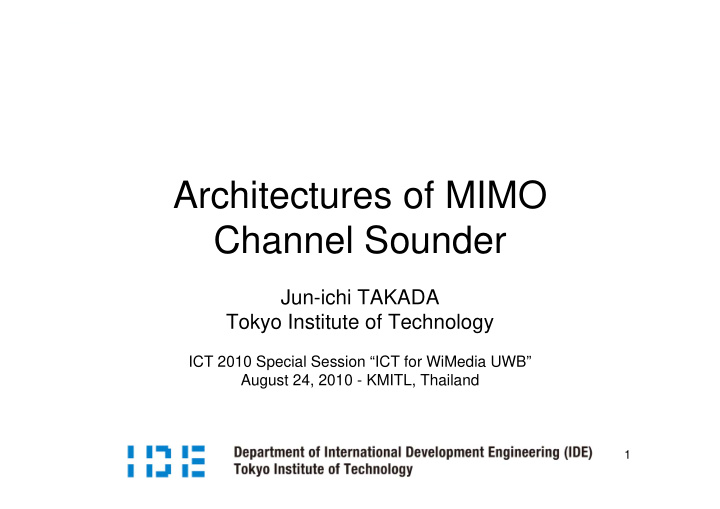



Architectures of MIMO Channel Sounder Jun-ichi TAKADA Tokyo Institute of Technology ICT 2010 Special Session “ICT for WiMedia UWB” August 24, 2010 - KMITL, Thailand 1
Ultra Wideband (UWB) Systems • FCC’s policy – Underlay: Level below unintentional emission -40 • Short range PSD e.i.r.p. [dBm/MHz] -50 – No frequency allocation -60 • Plenty of bandwidth EU -70 Japan – Potential broadband USA indoor -80 • Location awareness -90 3 4 5 6 7 8 9 10 11 – High resolution in delay domain Frequency [GHz] 2
Ultra Wideband (UWB) Systems • Example applications – WiMedia : High speed PAN – IEEE 802.15.4a : low speed, location aware – IEEE 802.15.6 : body area • Issues – Strong objections from victim systems – Too much emphasis on high speed PAN • Strong competitors: 802.15.3c and 802.11n • Large power consumption due to OFDM 3
Ultra Wideband (UWB) Systems • Advantages of impulse radio – Low power consumption – High resolution in time domain 4
UWB Channel Characterization • Two aspects of channel – Impulse response between Tx and Rx ports – Interference from other systems • System evaluation via channel model – Mathematical model based on measurements – To be standardized for comparison • Channel sounding – Measurement of channel impulse response 5
Radio Channel Rx Tx Rx Antennas and Propagation shall be separated in the model 6
Why shall Antennas and Propagation be separated in the model? • Antennas • Propagation – Manmade device – Natural phenomenon – Designed and – Given as condition controlled Quite different factors 7
Propagation Path Modeling Rx Tx Rx • Delay time (DT) Note: Just approximation • Doppler frequency (DF) • Directions of departure and arrival (DoD/DoA) • Magnitude (polarimetric) 8
Channel Sounding Measurement of channel property • Delay time – Wideband signal • Doppler frequency – Dynamic measurement • Directions – Array antennas • Magnitude – Sufficient power 9
Channel Sounder Architecture (1) VNA + synthetic array antenna (SAA) 10
Channel Sounder Architecture (2) • Time division multiplexing (TDM) – Available as commercial sounder CG CG AO Tx Rx AO LO LO storage AO: Atomic Oscillator, CG: Clock Generator, LO: Local Oscillator 11
Channel Sounder Architecture (3) • Full MIMO – Implemented by software radio platform Tx Rx Tx Rx CG CG AO AO LO LO Tx Rx Tx Rx AO: Atomic Oscillator, CG: Clock Generator, LO: Local Oscillator 12
Comparison among MIMO Sounder Architectures SAA TDM Full MIMO # of array Arbitrary # of MUXs # of Tx/Rx elements Doppler Impossible Slow Fast Speed Spatial MUX # of Tx & scan response Max delay HW Low High Very high Complexity 13
Comparison among MIMO Sounder Architectures SAA TDM Full MIMO Calibration Back-to- B-B, array B-B for all back RF pairs, array RF power Very small Large Small 14
TDM and Full MIMO Sounders • Measurement time only dominated by # of Rx – TDM and other Tx multiplexing need same time length for separation • Cost proportional to # of RF/BB chain – More expensive for high power • Hardware sharing for full MIMO – Extra storage needed for sounding 15
Static Double Directional Channel Rx Tx Rx Ω Ω H f , , Multipath Tx Rx L Ω Ω Ω Ω a f exp j 2 f l Tx Tx ,l Rx Rx ,l l l 1 16
Static SISO Channel Rx Tx Rx Similar to Friis’ formula H f Channel L Ω Ω a f H f , H f , exp j2 f l TxAntenna Tx ,l RxAntenna Rx ,l l l 1 17
Summary • Different MIMO channel sounder architectures – pros and cons • Issues skipped due to time constraint – Sounding signal design – Parameter estimation – Power handling – Measurement results 18
Synchronization between Tx and Rx Need of absolution synchronization • Clock timing – Absolute delay – Synchronization of multiplexer • Carrier frequency / phase – Coherence in TDM; array & Doppler – Separation of Tx signals in full MIMO 19
Synchronization between Tx and Rx • VNA (short range only) • Cable connection (short range only) • Atomic oscillator • GPS (outdoor only) 20
21
Recommend
More recommend